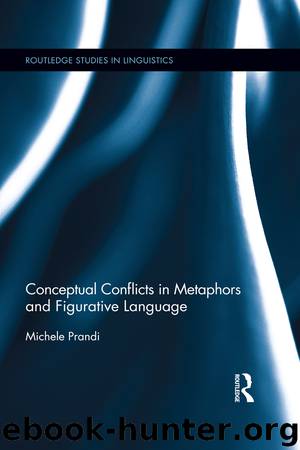Conceptual Conflicts in Metaphors and Figurative Language by Prandi Michele

Author:Prandi, Michele
Language: eng
Format: epub
Publisher: Taylor & Francis (CAM)
When no covert tenor is either accessible or relevant, the verbal metaphor opens up an alternative option, that is, a metaphorical characterization of the overt tenor, which coincides with the conflicting argument. In Therefore desire, of perfect love being made, / Shall neigh, no dull flesh, in his fiery race (Shakespeare), for instance, a consistent reformulation of the focal verb is out of reach, and the pressure of the conflict is displaced onto the overt tenor: the neighing desire is regarded as a horse.
If we compare metaphors of paradigmatic and syntagmatic structure we encounter a paradox. A metaphor of syntagmatic structure looks very radical in that it directly applies the pressure of the strange focus to the tenor; on the other hand, the tenor is necessarily given in praesentia, which implies that this kind of metaphor is primarily an instrument of re-categorization of an identified tenor. A metaphor of paradigmatic structure, for its part, appears rather regressive in that it opens the way to substitution by putting the focus under pressure; on the other hand, the tenor is not given in praesentia and in some cases is utterly out of reach. As we shall see in the next chapter, this form of metaphor foreshadows in its very structure one of the main functions of metaphorical thinking in general, both conflictual and consistent, which is valorized when a creative metaphor is put at the service of consistent thinking and highlighted in scientific discovery. A creative metaphor does not necessarily reshape the conceptual structure of a previously identified tenor; sometimes, it launches conceptual probes into an unknown territory, trying to impose on it a tentative shape and content according to a strange model. Its function is to colonize a wild territory to be annexed to the realm of thought. Before metaphorical projection receives content, for instance, there is no previous tenor for such expressions as natural selection or scientific revolution (see Ch. 7, § 3)
Finally, the different weight of the tenor marks a deep difference between metaphor and metonymy. Metonymy without a tenor is unthinkable—indeed, it is an outright contradiction. As a static relation, a metonymic link logically needs two terms. A metaphor devoid of tenor is an empirical datum; if metaphor is defined as the figure of projection, this fact is easily accounted for.
Download
This site does not store any files on its server. We only index and link to content provided by other sites. Please contact the content providers to delete copyright contents if any and email us, we'll remove relevant links or contents immediately.
Cecilia; Or, Memoirs of an Heiress — Volume 1 by Fanny Burney(32497)
Cecilia; Or, Memoirs of an Heiress — Volume 2 by Fanny Burney(31910)
Cecilia; Or, Memoirs of an Heiress — Volume 3 by Fanny Burney(31894)
The Lost Art of Listening by Michael P. Nichols(7454)
Asking the Right Questions: A Guide to Critical Thinking by M. Neil Browne & Stuart M. Keeley(5709)
We Need to Talk by Celeste Headlee(5571)
On Writing A Memoir of the Craft by Stephen King(4892)
Dialogue by Robert McKee(4353)
Pre-Suasion: A Revolutionary Way to Influence and Persuade by Robert Cialdini(4185)
I Have Something to Say: Mastering the Art of Public Speaking in an Age of Disconnection by John Bowe(3859)
Elements of Style 2017 by Richard De A'Morelli(3324)
The Book of Human Emotions by Tiffany Watt Smith(3269)
Fluent Forever: How to Learn Any Language Fast and Never Forget It by Gabriel Wyner(3054)
Name Book, The: Over 10,000 Names--Their Meanings, Origins, and Spiritual Significance by Astoria Dorothy(2960)
Good Humor, Bad Taste: A Sociology of the Joke by Kuipers Giselinde(2923)
Why I Write by George Orwell(2913)
The Art Of Deception by Kevin Mitnick(2769)
The Grammaring Guide to English Grammar with Exercises by Péter Simon(2723)
Ancient Worlds by Michael Scott(2650)
